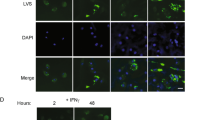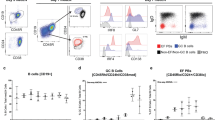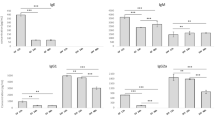Abstract
Here we investigate the dynamics of the hepatic intravascular immune response to a pathogen relevant to invariant natural killer T cells (iNKT cells). Immobilized Kupffer cells with highly ramified extended processes into multiple sinusoids could effectively capture blood-borne, disseminating Borrelia burgdorferi, creating a highly efficient surveillance and filtering system. After ingesting B. burgdorferi, Kupffer cells induced chemokine receptor CXCR3–dependent clustering of iNKT cells. Kupffer cells and iNKT cells formed stable contacts via the antigen-presenting molecule CD1d, which led to iNKT cell activation. An absence of iNKT cells caused B. burgdorferi to leave the blood and enter the joints more effectively. B. burgdorferi that escaped Kupffer cells entered the liver parenchyma and survived despite Ito cell responses. Kupffer cell–iNKT cell interactions induced a key intravascular immune response that diminished the dissemination of B. burgdorferi.
This is a preview of subscription content, access via your institution
Access options
Subscribe to this journal
Receive 12 print issues and online access
$209.00 per year
only $17.42 per issue
Buy this article
- Purchase on Springer Link
- Instant access to full article PDF
Prices may be subject to local taxes which are calculated during checkout







Similar content being viewed by others
References
Geissmann, F. et al. Intravascular immune surveillance by CXCR6+ NKT cells patrolling liver sinusoids. PLoS Biol. 3, e113 (2005).
Auffray, C. et al. Monitoring of blood vessels and tissues by a population of monocytes with patrolling behavior. Science 317, 666–670 (2007).
Kronenberg, M. Toward an understanding of NKT cell biology: progress and paradoxes. Annu. Rev. Immunol. 23, 877–900 (2005).
Kawano, T. et al. CD1d-restricted and TCR-mediated activation of Vα14 NKT cells by glycosylceramides. Science 278, 1626–1629 (1997).
Brossay, L. et al. CD1d-mediated recognition of an α-galactosylceramide by natural killer T cells is highly conserved through mammalian evolution. J. Exp. Med. 188, 1521–1528 (1998).
Kobayashi, E., Motoki, K., Uchida, T., Fukushima, H. & Koezuka, Y. KRN7000, a novel immunomodulator, and its antitumor activities. Oncol. Res. 7, 529–534 (1995).
Mattner, J. et al. Exogenous and endogenous glycolipid antigens activate NKT cells during microbial infections. Nature 434, 525–529 (2005).
Kinjo, Y. et al. Natural killer T cells recognize diacylglycerol antigens from pathogenic bacteria. Nat. Immunol. 7, 978–986 (2006).
Tupin, E. et al. NKT cells prevent chronic joint inflammation after infection with Borrelia burgdorferi. Proc. Natl. Acad. Sci. USA 105, 19863–19868 (2008).
You, Q., Cheng, L., Kedl, R.M. & Ju, C. Mechanism of T cell tolerance induction by murine hepatic Kupffer cells. Hepatology 48, 978–990 (2008).
MacPhee, P.J., Schmidt, E.E. & Groom, A.C. Evidence for Kupffer cell migration along liver sinusoids, from high-resolution in vivo microscopy. Am. J. Physiol. 263, G17–G23 (1992).
Egen, J.G. et al. Macrophage and T cell dynamics during the development and disintegration of mycobacterial granulomas. Immunity 28, 271–284 (2008).
Baer, K. et al. Kupffer cells are obligatory for Plasmodium yoelii sporozoite infection of the liver. Cell. Microbiol. 9, 397–412 (2007).
Dory, D. et al. Generation and functional characterization of a clonal murine periportal Kupffer cell line from H-2Kb-tsA58 mice. J. Leukoc. Biol. 74, 49–59 (2003).
Niess, J.H. et al. CX3CR1-mediated dendritic cell access to the intestinal lumen and bacterial clearance. Science 307, 254–258 (2005).
Wake, K. Hepatic stellate cells: Three-dimensional structure, localization, heterogeneity and development. Proc. Jpn. Acad. Ser B 82, 155–164 (2006).
Velázquez, P. et al. Cutting edge: activation by innate cytokines or microbial antigens can cause arrest of natural killer T cell patrolling of liver sinusoids. J. Immunol. 180, 2024–2028 (2008).
Johnston, B., Kim, C.H., Soler, D., Emoto, M. & Butcher, E.C. Differential chemokine responses and homing patterns of murine TCR αβ NKT cell subsets. J. Immunol. 171, 2960–2969 (2003).
Wilson, M.T. et al. The response of natural killer T cells to glycolipid antigens is characterized by surface receptor down-modulation and expansion. Proc. Natl. Acad. Sci. USA 100, 10913–10918 (2003).
van Rooijen, N. & Sanders, A. Liposome mediated depletion of macrophages: mechanism of action, preparation of liposomes and applications. J. Immunol. Methods 174, 83–93 (1994).
Junt, T. et al. Subcapsular sinus macrophages in lymph nodes clear lymph-borne viruses and present them to antiviral B cells. Nature 450, 110–114 (2007).
Audoy-Rémus, J. et al. Rod-Shaped monocytes patrol the brain vasculature and give rise to perivascular macrophages under the influence of proinflammatory cytokines and angiopoietin-2. J. Neurosci. 28, 10187–10199 (2008).
Bernardino, A.L., Myers, T.A., Alvarez, X., Hasegawa, A. & Philipp, M.T. Toll-like receptors: insights into their possible role in the pathogenesis of Lyme neuroborreliosis. Infect. Immun. 76, 385–395 (2008).
Vieira, O.V., Botelho, R.J. & Grinstein, S. Phagosome maturation: aging gracefully. Biochem. J. 366, 689–704 (2002).
Savina, A. & Amigorena, S. Phagocytosis and antigen presentation in dendritic cells. Immunol. Rev. 219, 143–156 (2007).
Winau, F. et al. Ito cells are liver-resident antigen-presenting cells for activating T cell responses. Immunity 26, 117–129 (2007).
Zanchi, A.C., Gingold, A.R., Theise, N.D. & Min, A.D. Necrotizing granulomatous hepatitis as an unusual manifestation of Lyme disease. Dig. Dis. Sci. 52, 2629–2632 (2007).
Zaidi, S.A. & Singer, C. Gastrointestinal and hepatic manifestations of tickborne diseases in the United States. Clin. Infect. Dis. 34, 1206–1212 (2002).
Warren, A. et al. T lymphocytes interact with hepatocytes through fenestrations in murine liver sinusoidal endothelial cells. Hepatology 44, 1182–1190 (2006).
Schmid, G.P. Epidemiology and clinical similarities of human spirochetal diseases. Rev. Infect. Dis. 11 Suppl 6, S1460–S1469 (1989).
Norman, M.U., Hulliger, S., Colarusso, P. & Kubes, P. Multichannel fluorescence spinning disk microscopy reveals early endogenous CD4 T cell recruitment in contact sensitivity via complement. J. Immunol. 180, 510–521 (2008).
Moriarty, T.J. et al. Real-time high resolution 3D imaging of the Lyme disease spirochete adhering to and escaping from the vasculature of a living host. PLoS Pathog. 4, e1000090 (2008).
Barbour, A.G. Isolation and cultivation of Lyme disease spirochetes. Yale J. Biol. Med. 57, 521–525 (1984).
Kawabata, H., Norris, S.J. & Watanabe, H. BBE02 disruption mutants of Borrelia burgdorferi B31 have a highly transformable, infectious phenotype. Infect. Immun. 72, 7147–7154 (2004).
Ato, M. et al. Loss of dendritic cell migration and impaired resistance to Leishmania donovani infection in mice deficient in CCL19 and CCL21. J. Immunol. 176, 5486–5493 (2006).
Belperio, J.A. et al. Critical role for CXCR3 chemokine biology in the pathogenesis of bronchiolitis obliterans syndrome. J. Immunol. 169, 1037–1049 (2002).
Faunce, D.E., Palmer, J.L., Paskowicz, K.K., Witte, P.L. & Kovacs, E.J. CD1d-restricted NKT cells contribute to the age-associated decline of T cell immunity. J. Immunol. 175, 3102–3109 (2005).
Kajiwara, T. et al. Effects of cyclosporin A on the activation of natural killer T cells induced by alpha-galactosylceramide. Transplantation 27, 184–192 (2007).
Benhnia, M.R. et al. Signaling through CD14 attenuates the inflammatory response to Borrelia burgdorferi, the agent of Lyme disease. J. Immunol. 174, 1539–1548 (2005).
Acknowledgements
We thank D.R. Littman (New York University School of Medicine) for Cxcr6gfp/gfp and Cx3cr1gfp/gfp mice; E. Allen-Vercoe (University of Guelph) for GFP-expressing and nonfluorescent E. coli; G. Chaconas and P.-O. Hardy for help with the preparation of B. burgdorferi; and B. Millen and P. Colarusso for training and assistance related to spinning-disk confocal microscopy. Supported by the Canadian Institutes of Health Research (P.K. and T.J.M. and MOP-53086 to G.C.), the Crohn's and Colitis Foundation of Canada (P.K.), the Canadian Association of Gastroenterology (W.-Y.L.), the Canada Research Chairs Program (G.C. and P.K.) and the Alberta Heritage Foundation for Medical Research (G.C., P.K. and T.J.M.).
Author information
Authors and Affiliations
Contributions
W.-Y.L. and T.J.M. designed and did most of the experiments and prepared the manuscript; C.H.Y.W. and H.Z. did some intravital and cell culture experiments; R.M.S. provided anti-CXCR3 serum and helped design anti-CXCR3 experiments; N.v.R. provided CLLs and intellectual input; G.C. provided supervision for the preparation of fluorescent B. burgdorferi and prepared the manuscript; and P.K. provided overall supervision, helped design all the experiments and prepared the manuscript.
Corresponding author
Ethics declarations
Competing interests
The authors declare no competing financial interests.
Supplementary information
Supplementary Text and Figures
Supplementary Figures 1–8, Supplementary Table 1 and Supplementary Methods (PDF 1138 kb)
Supplementary Video 1
Distribution and movement of iNKT cells in the hepatic sinusoids of Cxcr6gfp/+ mouse. Low magnification (×4) video shows the general crawling pattern of iNKT cells. Experimental conditions were as described in the Figure 1a legend and in more detailed Supplementary Methods. Elapsed time is shown at the top right. The time lapse was recorded at 0.3 fps and exported to video at 30 fps. (MOV 923 kb)
Supplementary Video 2
iNKT cell movement in the hepatic sinusoids of Cxcr6gfp/+ mouse. Intermediate magnification (×10) video shows the general crawling pattern of iNKT cells. Experimental conditions were as described in the Figure 1b legend and in more detailed Supplementary Methods. Elapsed time is shown at the top right. The time lapse was recorded at 0.3 fps and exported to video at 30 fps. (MOV 939 kb)
Supplementary Video 3
Differential behavior of iNKT cells and Kupffer cells in the hepatic sinusoids of Cxcr6gfp/+ mouse. Intermediate magnification (×10) video shows the procedure of Kupffer cell labelling and behavioral patterns of iNKT cells/Kupffer cells. Experimental conditions were as described in the Supplementary Methods. Elapsed time is shown at the top right. The time lapse was recorded at 0.3 fps and exported to video at 30 fps. (MOV 2258 kb)
Supplementary Video 4
Distribution and behavior of iNKT cells. Intermediate magnification (×10) video shows that iNKT cells are localized widely within sinusoids, but rarely in venules. iNKT cells that attempted to move into post-sinusoidal venule were often swept away (indicated by arrow). Experimental conditions were as described in the Supplementary Methods. Elapsed time is shown at the top right. The time lapse was recorded at 0.3 fps and exported to video at 30 fps. (MOV 2391 kb)
Supplementary Video 5
Filtering function of Kupffer cells in the hepatic sinusoids I. High magnification (×20) video shows the typical binding pattern of foreign molecules between Kupffer cells and beads. Experimental conditions were as described in the Figure 1c, 2a and 2b legends and in more detailed Supplementary Methods. Elapsed time is shown at the top right. The time lapse was recorded at 0.3 fps and exported to video at 30 fps. (MOV 1428 kb)
Supplementary Video 6
Strikingly different behavior for B. burgdorferi attached to Kupffer cells and endothelium. High magnification (×20) video shows that B. burgdorferi bound to Kupffer cells were relatively immobilized (indicated by arrow) when compared to endothelium (indicated by arrowhead; moved back and forth over 10-20 μm). Experimental conditions were as described in the Supplementary Methods. Elapsed time is shown at the top right. The time lapse was recorded at 0.3 fps and exported to video at 30 fps. (MOV 596 kb)
Supplementary Video 7
The cluster formed by iNKT cells 24 h after B. burgdorferi treatment I. Intermediate magnification (×10) video shows a big iNKT cluster at 24 h after B. burgdorferi treatment. Experimental conditions were as described in the Figure 5f legend and in more detailed Supplementary Methods. Elapsed time is shown at the top right. The time lapse was recorded at 0.3 fps and exported to video at 30 fps. (MOV 567 kb)
Supplementary Video 8
The cluster formed by iNKT cells 24 h after B. burgdorferi treatment II. High magnification (×20) video shows a big iNKT cluster formed on Kupffer cells 24 h after B. burgdorferi treatment and few spirochetes in the liver. Experimental conditions were as described in the Figure 5f and 5g legend and in more detailed Supplementary Methods. Elapsed time is shown at the top right. The time lapse was recorded at 0.3 fps and exported to video at 30 fps. (MOV 770 kb)
Supplementary Video 9
Filtering function of Kupffer cells in the hepatic sinusoids II. At 12 h after B. burgdorferi treatment, high magnification (×20) video shows that Kupffer cell-depleted liver could not clear the pathogens. Experimental conditions were as described in the Supplementary Methods. Elapsed time is shown at the top right. The time lapse was recorded at 0.3 fps and exported to video at 30 fps. (MOV 690 kb)
Supplementary Video 10
iNKT crawling in anti-CD1d antibody treated mouse liver at 24 h after B. burgdorferi treatment. Intermediate magnification (×10) video shows that anti-CD1d did not reduce the speed with which the iNKT cells crawl in the sinusoids, while it inhibited iNKT cluster formation. A small cluster of iNKT cells is seen in the video, but iNKT cells are still crawling on Kupffer cells. Experimental conditions were as described in the Methods. Elapsed time is shown at the top right. The time lapse was recorded at 0.2 fps and exported to video at 30 fps. (MOV 515 kb)
Rights and permissions
About this article
Cite this article
Lee, WY., Moriarty, T., Wong, C. et al. An intravascular immune response to Borrelia burgdorferi involves Kupffer cells and iNKT cells. Nat Immunol 11, 295–302 (2010). https://doi.org/10.1038/ni.1855
Received:
Accepted:
Published:
Issue Date:
DOI: https://doi.org/10.1038/ni.1855
This article is cited by
-
Differential location of NKT and MAIT cells within lymphoid tissue
Scientific Reports (2022)
-
Cirrhosis-associated immune dysfunction
Nature Reviews Gastroenterology & Hepatology (2022)
-
Re-programming mouse liver-resident invariant natural killer T cells for suppressing hepatic and diabetogenic autoimmunity
Nature Communications (2022)
-
The YAP/HIF-1α/miR-182/EGR2 axis is implicated in asthma severity through the control of Th17 cell differentiation
Cell & Bioscience (2021)
-
Reduced dose of PTCy followed by adjuvant α-galactosylceramide enhances GVL effect without sacrificing GVHD suppression
Scientific Reports (2021)



